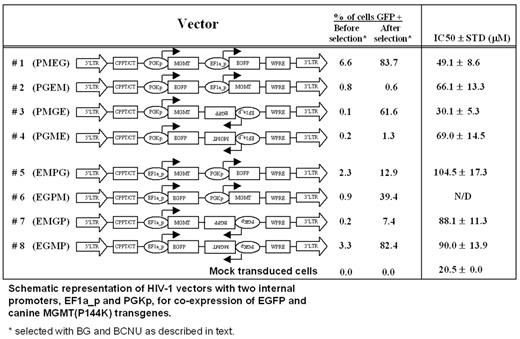Abstract
There are several gene therapy approaches, which require transfer and co-expression of two transgenes within one target cell. To this end, we have created and tested two-gene expression HIV-1 based vectors, which encode enhanced green fluorescent protein (EGFP) and P144K mutant of canine O6-methylguanine-DNA-methyltransferase (MGMT) transgenes under either the phosphoglycerate kinase gene promoter (PGKp), or the elongation factor 1 alpha promoter (EF1a_p). Eight different configurations of the two transgene expression cassettes were created and tested within the same lentiviral backbone (see Figure). Individual VSV-G pseudotyped vectors stocks were produced and used for infection of canine thyroid adenocarcinoma (CTAC) cells at low multiplicity of infection (MOI = 0.1) to ensure 1 copy of proviral vector per transduced cell. The cells were harvested one week later and an aliquot was assayed for EGFP expression by flow cytometry. Another portion was subjected to selection with O6-benzylguanine (BG, 40 m M for 18 hrs) and 1,3-bis(2-chloroethyl)-1-nitrosourea (BCNU, 100 m M for 2 hrs) and kept in culture for additional two weeks to eliminate cells expressing insufficient MGMT. The percentage of GFP positive cells, prior to selection with BG and BCNU, ranged between 0.1 % to 6.6% for the dual-transgene expression cassette encoding HIV-1 vectors. Following selection with BG and BCNU, the percentage of GFP positive cells increased for all vectors with the exception of vector #2 PGEM. Two of the vectors (#1 PMEG and #8 EGMP) demonstrated over 80% GFP positivity after selection. The results of flow cytometry after selection were corroborated by fluorescence microscopy of individual BCNU-resistant colonies. GFP expression was readily detected in drug-resistant colonies transduced with vectors #1 PMEG or #8 EGMP. Weaker GFP expression was detected in drug resistant cells transduced with vectors #3 PMGE, #5 EMPG or #6 EGPM. No significant GFP expression was observed in drug-resistant colonies transduced with vectors #2 PGEM, #4 PGME or #7 EMGP. Drug resistance to BCNU (IC50 values) provided by each of the vectors, was also determined. The data showed that the IC50 values for #1 PMEG and #8 EGMP vectors were 2.4-fold and 4.4-fold, respectively, higher than for mock transduced control cells. The above results indicate that coordinated co-expression of two transgenes using independent expression cassettes is promoter, position and orientation dependent. The data also indicate that two potentially useful vectors (#1 PMEG and #8 EGMP) have been identified for evaluation, ex vivo and in vivo, in the canine model for co-expression of two transgenes.
Author notes
Corresponding author


This feature is available to Subscribers Only
Sign In or Create an Account Close Modal